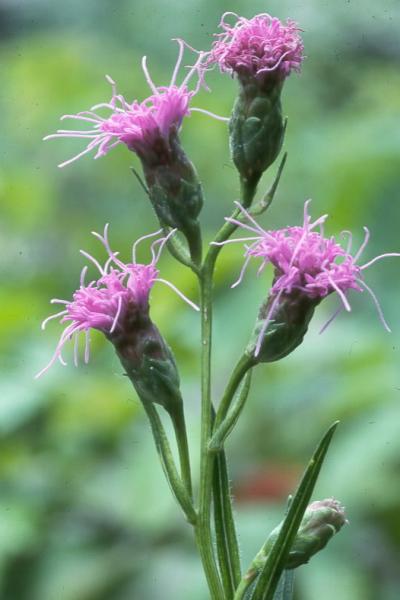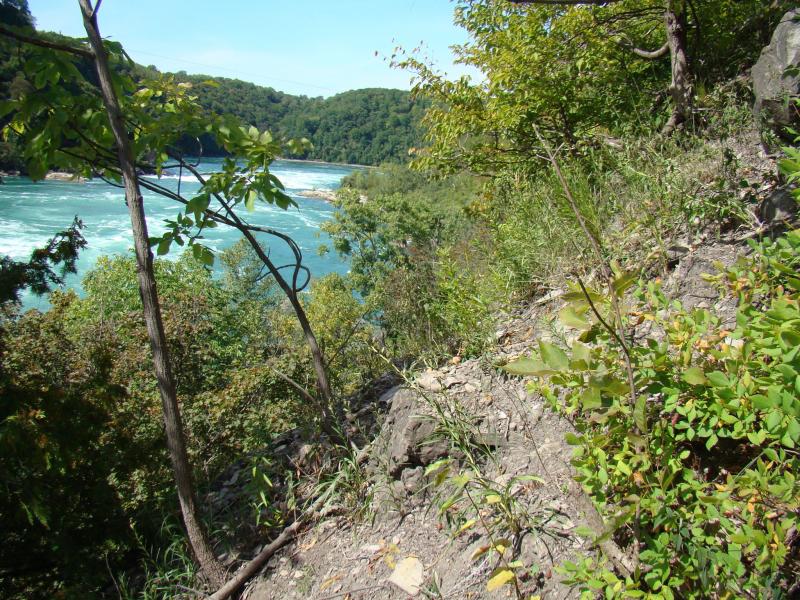Few-headed Blazing Star
Liatris cylindracea Michx.
- Class
- Dicotyledoneae (Dicots)
- Family
- Asteraceae (Aster Family)
- State Protection
- Endangered
Listed as Endangered by New York State: in imminent danger of extirpation in New York. For animals, taking, importation, transportation, or possession is prohibited, except under license or permit. For plants, removal or damage without the consent of the landowner is prohibited.
- Federal Protection
- Not Listed
- State Conservation Status Rank
- S1
Critically Imperiled in New York - Especially vulnerable to disappearing from New York due to extreme rarity or other factors; typically 5 or fewer populations or locations in New York, very few individuals, very restricted range, very few remaining acres (or miles of stream), and/or very steep declines.
- Global Conservation Status Rank
- G5
Secure globally - Common in the world; widespread and abundant (but may be rare in some parts of its range).
Summary
Did you know?
The presence of Liatris cylindracea at Niagara Falls was first publishing in the Flora of New York by John Torrey in 1843. It has never been found in any other place in the state.
State Ranking Justification
There is one existing population that has been known since 1839. No other historical records are known for the species.
Short-term Trends
The plants have been relatively stable in numbers over the years even though they have been impacted by visitors.
Long-term Trends
The plants have been relatively stable in numbers over the years even though they have been impacted by visitors. Numbers of plants were not recorded in the 1800s or early 1900s.
Conservation and Management
Threats
The plants are threatened by improper trail maintenance activities and increased recreational use of the trails. There are some invasive species nearby.
Conservation Strategies and Management Practices
Make sure personnel who are maintaining the trails know the locations of the plant so they can be avoided. Suppress invasive species in the area of the plants.
Research Needs
Research is needed to see if the local population could be augmented through seed propagation.
Habitat
Habitat
The sole known New York population is found amid a calcareous talus slope in the Niagara River gorge (NYNHP 2013). Prairies, limestone outcrops, bluffs, barrens, and glades, marl, sandstone outcrops, dunes, roadsides, sandy pine-oak, wooded northern slopes (Nesom 2006). Dry sandy jack pine, oak, aspen woodland; fields, dunes, and prairies (Voss 1996). Dry, open places (Gleason and Cronquist 1991). Dry calcareous or siliceous soil (Fernald 1950).
Associated Ecological Communities
- Calcareous talus slope woodland
(guide)
An open or closed canopy community that occurs on talus slopes composed of calcareous bedrock such as limestone or dolomite. The soils are usually moist and loamy; there may be numerous rock outcrops.
Associated Species
- Achillea millefolium (yarrow)
- Anemone virginiana (tall anemone, thimbleweed)
- Asclepias tuberosa (butterfly-weed)
- Asclepias verticillata (whorled milkweed)
- Fraxinus americana (white ash)
- Helianthus divaricatus (woodland sunflower)
- Juniperus virginiana
- Melilotus albus (white sweet-clover)
- Oligoneuron album
- Panicum virgatum (switch grass)
- Pellaea glabella ssp. glabella (smooth cliff-brake)
- Prunus virginiana
- Rhamnus cathartica (European buckthorn)
- Solidago flexicaulis (zig-zag goldenrod)
- Symphyotrichum oolentangiense (sky-blue-aster)
- Symphyotrichum urophyllum (arrow-leaved-aster)
- Thuja occidentalis (northern white cedar, arbor vitae)
- Toxicodendron radicans
- Trichostema brachiatum (false pennyroyal)
Range
New York State Distribution
In New York state Slender bBazing-star is known only from Niagara County.
Global Distribution
Liatris cylindracea reaches the northeastern limit of its range in New York. Its range is centered on the Great Lakes and Mississippi Valley regions, extending from Ontario to Minnesota in the north and from Oklahoma to Georgia in the south.
Identification Comments
General Description
Liatris cylindracea is a native, erect perennial growing from a swollen underground stem base (corm) to an overall height of 20 to 60 cm. The stems are smooth and hairless (glabrous) and the leaves are 3(-5) nerved, 0.8 to 2.5 cm long and generally linear. Since Liatris is in the aster family, the infloresences are arranged radially into "heads" of many separate ray and disc flowers, superficially resembling a single flower. The flowering heads of Slender Blazing-star are borne singly or in elongated or spike-like arrangements. The flowering heads are rose or pink-colored and sessile or spreading-ascending on 2 to 10(-20) mm stalks. The whorls of bracts (involucre) encompassing the flower heads are bell-shaped and (11-)13 to 18 mm long by 6 to 8 mm wide, The involucres enclosing the flower heads are comprised of individual bracts (phyllaries) that are leathery, stiff and tough, with thin, membranous, translucent margins. These phyllaries occur in series of 5 to 7, and are strongly unequal (the outer ones are shorter). The fruits are one-seeded and 5 to 7 mm long, and bear feather-like (plumose) tufts of bristles on the top that have lateral branches more than 8 times longer than the diameter of the main bristle. (Nesom 2006)
Identifying Characteristics
Liatris cylindracea is a native, erect perennial growing from a swollen underground stem base (corm) to an overall height of 20 to 60 cm. The stems are smooth and hairless (glabrous) and the leaves are 3(-5) nerved, 0.8 to 2.5 cm long and generally linear in overall character. The flowering heads are borne singly or 2 to 28 in loose to dense elongated or spike-like arrangements (array). The flowering heads are typically comprised of 10 or more individual rose-pink colored flowers, and are sessile or spreading-ascending on 2 to 10(-20) mm stalks (peduncles). The whorls of bracts (involucre) encompassing the flower heads are bell-shaped to broadly bell-shaped and (11-)13 to 18 mm long by 6 to 8 mm wide, The involucral bracts (phyllaries) are leathery, stiff and tough, but both somewhat flexible and lustrous, with typically narrow, thin, membranous, translucent (hyaline) margins. They occur 5 to 7 in series, are strongly unequal (the outer ones are shorter), either tightly appressed or slightly loose, and egg-shaped round-tipped abruptly short pointed or abruptly tapering to a point. The fruits are dry, indehiscent, one-seeded (cypselae) and 5 to 7 mm long. The fruits bear feather-like (plumose) tufts of bristles on the top that have lateral branches over 8 times longer than the diameter of the main bristle. (Nesom 2006)
Best Life Stage for Proper Identification
The entire stem with intact leaves, flowering heads and mature fruits is best for positive identification.
Similar Species
All other Liatris species in New York can be distinguished from L. cylindracea by their strongly barbed tuft of bristles (pappus) on the top of their fruit which have lateral branches less than 5 times longer than the diameter of the main bristle. Liatris cylindracea also typically has only one to a few bell-shaped flowering heads while our other species have several to many cylindrical or button-shaped flowering heads. L.aspera and L. pycnostachya also have reflexed or spreading involucural bracts, while L. cylindracea's are appressed or only slightly loose (Voss 1996).
Best Time to See
Liatris cylindracea typically flowers starting in mid-July and continuing through late August. Fruiting typically occurs from mid-August through mid-September.
- Flowering
- Fruiting
The time of year you would expect to find Few-headed Blazing Star flowering and fruiting in New York.
Few-headed Blazing Star Images
Taxonomy
Few-headed Blazing Star
Liatris cylindracea Michx.
- Kingdom Plantae
- Phylum Anthophyta
- Class Dicotyledoneae
(Dicots)
- Order Asterales
- Family Asteraceae (Aster Family)
- Order Asterales
- Class Dicotyledoneae
(Dicots)
- Phylum Anthophyta
Additional Common Names
- Blazing-star
- Slender Blazing Star
Synonyms
- Lacinaria cylindrica (Michx.) Kuntze
Additional Resources
Best Identification Reference
Nesom, G. L. 2006. Liatris Gaertner ex Schreber Pages 512-535 in: Flora of North America Editorial Committee. 2006c. Flora of North America North of Mexico. Vol. 21. Magnoliophyta: Asteridae, part 8: Asteraceae, part 3. Oxford Univ. Press, New York. xxii + 616 pp.
Other References
Fernald, M. L. 1950. Gray's manual of botany. 8th edition. Corrected printing (1970). D. Van Nostrand Company, New York. 1632 pp.
Gleason, Henry A. and A. Cronquist. 1991. Manual of Vascular Plants of Northeastern United States and Adjacent Canada. The New York Botanical Garden, Bronx, New York. 910 pp.
Holmgren, Noel. 1998. The Illustrated Companion to Gleason and Cronquist's Manual. Illustrations of the Vascular Plants of Northeastern United States and Adjacent Canada. The New York Botanical Garden, Bronx, New York.
Mitchell, Richard S. and Gordon C. Tucker. 1997. Revised Checklist of New York State Plants. Contributions to a Flora of New York State. Checklist IV. Bulletin No. 490. New York State Museum. Albany, NY. 400 pp.
New York Natural Heritage Program. 2024. New York Natural Heritage Program Databases. Albany, NY.
Voss, E.G. 1996. Michigan Flora. Part III. Dicots (Pyrolaceae-Compositae). Cranbrook Institute of Science Bulletin 61 and Univ. Michigan Herbarium. Ann Arbor, Michigan. 622 pp.
Weldy, T. and D. Werier. 2010. New York flora atlas. [S.M. Landry, K.N. Campbell, and L.D. Mabe (original application development), Florida Center for Community Design and Research http://www.fccdr.usf.edu/. University of South Florida http://www.usf.edu/]. New York Flora Association http://newyork.plantatlas.usf.edu/, Albany, New York
Links
About This Guide
This guide was authored by: Stephen M. Young, Elizabeth Spencer, Richard M. Ring.
Information for this guide was last updated on: April 2, 2013
Please cite this page as:
New York Natural Heritage Program. 2024.
Online Conservation Guide for
Liatris cylindracea.
Available from: https://guides.nynhp.org/slender-blazing-star/.
Accessed July 26, 2024.

